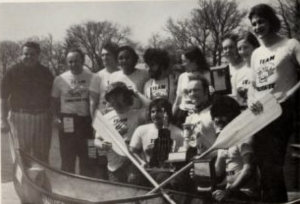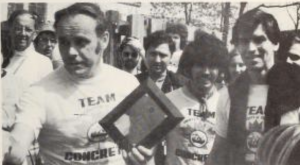How a breakfast cereal led to beating U.S. competitors and a patent
For the last 24 years engineering students in Canada have been competing in the annual Canadian National Concrete Canoe Competition (CNCCC) but concrete canoes were being built at U of T long before the first CNCCC event.
In 1973 Civil Engineering (CivE) Professor Emeritus John Timusk and Professor Emeritus Ken Selby launched University of Toronto’s first concrete canoe into the Toronto Harbour. The canoe, which weighed 120 pounds, was completed the night before and took CivE students six hours to make.

At the time Prof. Timusk was working on various mixes for insulated concrete; the first insulating material he used were Styrofoam beads. Then he thought to use an organic material.
“It occurred to me, why don’t we use puffed wheat? Imagine that!” Timusk recalls.
To prevent the cereal grain from going soggy, Timusk experimented dipping the puffed wheat into boiling wax. By a lucky mistake, one of them turned into carbon, from too much heat.
“I said ‘Eureka! we got a product here!,’” Timusk recalls. This led to other formulas for insulated concrete using glass fibres and cement paste, which were later patented by Timusk.
Under the direction of Prof. Timusk, CivE students were using insulated concrete for various extracurricular projects. First, they made a concrete igloo, a concrete motorboat and then came U of T’s first concrete canoe in 1973.
Concrete Canoe races had been held in the United States since the 1960s, with U of T becoming the first Canadian university to enter the competition in 1974, then hosted at Notre Dame University in Indiana.


Using Prof. Timusk’s patented insulated concrete formula, U of T entered with an ultra-lightweight canoe, weighing only 78 pounds.
“Our canoe was so much lighter, we travelled with it on the roof rack of a car,” said Timusk.
The 78-pound winning concrete canoe now resides at the Canadian Canoe Museum in Peterborough, Ont.
Prof. Ken Selby and Prof. Cameron Kenney, who was Department Chair at the time, paddled the canoe in the staff division of the race, winning first place.
The win from the upstart Canadian entry caused jealousy amongst the U.S. universities, who expressly did not want to compete with U of T’s new innovations in concrete. Timusk jokes, "That was probably the first and last concrete canoe competition we went to in the States."
By this time, there were other university concrete canoe races starting in Ontario. Races were held at Grenadier Pond in Toronto’s High Park and at the former Lady Eaton Estate, now a Seneca College campus, near King City, Ont.
Prof. Ken Selby recalls a race at Lake Seneca, where he and Prof. Cameron Kenney were paddling in a staff division race. Three-quarters through the race, Kenney fell out of the canoe into the lake but Selby kept paddling on.
“There were a whole bunch of other boats, so I didn’t want to cause a scene picking him up!” Selby chuckles as he recounts the memory.

For years, Prof. Selby and Prof. Timusk enjoyed concrete canoe competitions. “The more we do this, the more the students become independent, they start to work in teams and this is all in their spare time,” said Timusk.
Today, the U of T Concrete Canoe Club is an interdisciplinary design team, attracting students from all departments in the faculty.
This year the CNCCC went virtual and asked teams to submit an analysis on a past canoe in a technical report. Last month, the U of T Concrete Canoe Team submitted a report on its 2018-2019 canoe, the Polaris, earning second place in the competition.
By: Rebecca Logan